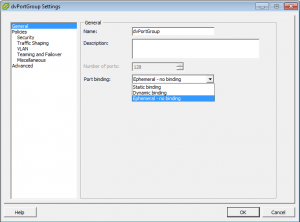A few people have been asking what Ephemeral ports are and what is there purpose. This is a quick overview. So what is an Ephemeral port? An Ephemeral Port stops the binding of a dvPort. This resembles the same behaviour in the standard vSwitch. This can be used when port history is not required or relevant. You can see on the screen shot below the three types of Port Binding available on a dvSwitch port group. The three types of port binding available: Static Binding (Default): means that the dvPort will be assigned to the VM at configuration time. Once all the ports are “booked” by VMs, it will not be possible to connect another VM, even if the connected VMs are powered up or not. Dynamic Binding: means that the dvPort will be assigned at the moment of VM power-up. This option allows for over committing the number of […]

